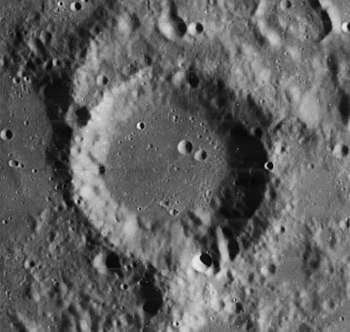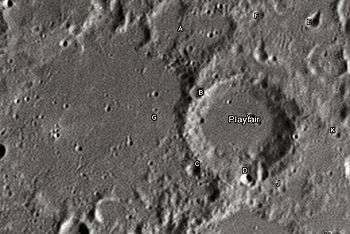Playfair (lunar crater)
 Lunar Orbiter 4 image | |
| Coordinates | 23°30′N 8°24′E / 23.5°N 8.4°ECoordinates: 23°30′N 8°24′E / 23.5°N 8.4°E |
|---|---|
| Diameter | 47 km |
| Depth | 2.9 km |
| Colongitude | 302° at sunrise |
| Eponym | John Playfair |
Playfair is a lunar impact crater that is located in the rugged southern highlands on the near side of the Moon. It lies along the eastern rim of the eroded satellite crater Playfair G, a formation that is almost twice the diameter of Playfair itself. Playfair is nearly due north of the crater Apianus, and to the southwest of the Abenezra–Azophi crater pair.
This crater is oval in shape, being slightly wider along the east–west axis. The rim is somewhat eroded, and tiny craterlets lie along the south and west rims. The interior floor is level and nearly featureless, with the only feature of the minor interest being a pair of tiny craterlets lying just to the east of the midpoint.
Names
Playfair is named after the Scottish scientist and mathematician John Playfair.[1] The name applies as official international standard since 1935 and is registered at the International Astronomical Union (IAU).[2] Earlier lunar cartographers had given the feature different names. Michael van Langren's 1645 map calls it "Valerii", likely after a Valerius.[3][4] It was the probable location where Johannes Hevelius called it "Celenorum Tumulus" of the ancient world.[3][5] After the 1651 nomenclature made by Giovanni Riccioli, the crater was left unnamed for about two centuries.
Satellite craters

By convention these features are identified on lunar maps by placing the letter on the side of the crater midpoint that is closest to Playfair.
| Playfair | Latitude | Longitude | Diameter |
|---|---|---|---|
| A | 22.3° S | 6.9° E | 21 km |
| B | 23.2° S | 7.6° E | 6 km |
| C | 24.3° S | 8.0° E | 5 km |
| D | 24.3° S | 8.8° E | 5 km |
| E | 21.7° S | 8.9° E | 6 km |
| F | 21.9° S | 8.1° E | 5 km |
| G | 24.2° S | 6.7° E | 94 km |
| H | 23.3° S | 8.5° E | 4 km |
| J | 24.3° S | 9.3° E | 4 km |
| K | 23.3° S | 9.8° E | 4 km |
Notes
- ↑ "Gazetteer of Planetary Nomenclature | Playfair". usgs.gov. International Astronomical Union. Retrieved August 25, 2017.
- ↑ M. A. Blagg; K. Müller; W. H. Wesley; S. A. Saunder; J. H. G. Franz (1935). Named Lunar Formations. London: Percy Lund, Humphries & Co. Ltd.
- 1 2 Ewen A. Whitaker, Mapping and Naming the Moon (Cambridge University Press, 1999)evel
- ↑ Langrenus map of the Moon (1645)
- ↑ Hevelius map of the Moon (1647)
References
- Andersson, L. E.; Whitaker, E. A. (1982). NASA Catalogue of Lunar Nomenclature. NASA RP-1097.
- Blue, Jennifer (July 25, 2007). "Gazetteer of Planetary Nomenclature". USGS. Retrieved 2007-08-05.
- Bussey, B.; Spudis, P. (2004). The Clementine Atlas of the Moon. New York: Cambridge University Press. ISBN 978-0-521-81528-4.
- Cocks, Elijah E.; Cocks, Josiah C. (1995). Who's Who on the Moon: A Biographical Dictionary of Lunar Nomenclature. Tudor Publishers. ISBN 978-0-936389-27-1.
- McDowell, Jonathan (July 15, 2007). "Lunar Nomenclature". Jonathan's Space Report. Retrieved 2007-10-24.
- Menzel, D. H.; Minnaert, M.; Levin, B.; Dollfus, A.; Bell, B. (1971). "Report on Lunar Nomenclature by the Working Group of Commission 17 of the IAU". Space Science Reviews. 12 (2): 136–186. Bibcode:1971SSRv...12..136M. doi:10.1007/BF00171763.
- Moore, Patrick (2001). On the Moon. Sterling Publishing Co. ISBN 978-0-304-35469-6.
- Price, Fred W. (1988). The Moon Observer's Handbook. Cambridge University Press. ISBN 978-0-521-33500-3.
- Rükl, Antonín (1990). Atlas of the Moon. Kalmbach Books. ISBN 978-0-913135-17-4.
- Webb, Rev. T. W. (1962). Celestial Objects for Common Telescopes (6th revised ed.). Dover. ISBN 978-0-486-20917-3.
- Whitaker, Ewen A. (1999). Mapping and Naming the Moon. Cambridge University Press. ISBN 978-0-521-62248-6.
- Wlasuk, Peter T. (2000). Observing the Moon. Springer. ISBN 978-1-85233-193-1.
| Wikimedia Commons has media related to Playfair (lunar crater). |